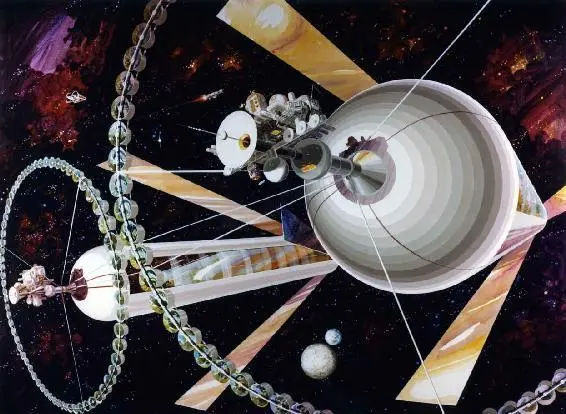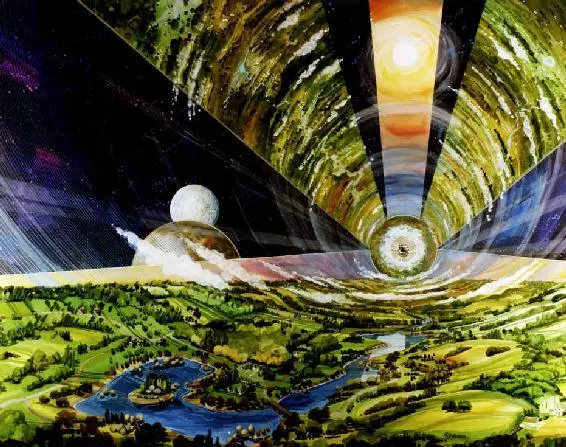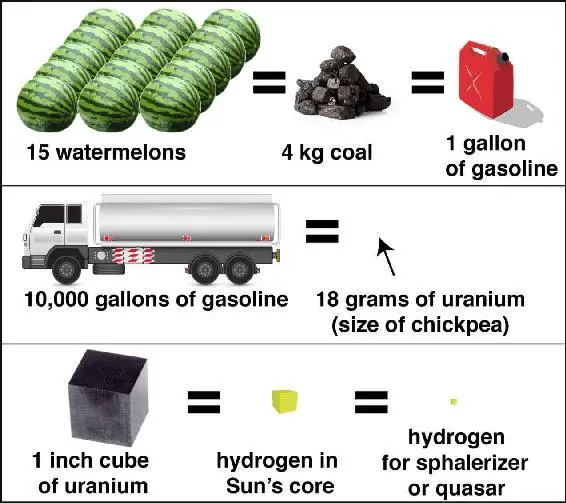If a much heavier rigid Dyson sphere is desired here in our Solar System, then resisting the Sun’s gravity will require ultra-strong materials that can withstand pressures tens of thousands of times greater than those at the base of the world’s tallest skyscrapers, without liquefying or buckling. To be long-lived, a Dyson sphere would need to be dynamic and intelligent, constantly fine-tuning its position and shape in response to disturbances and occasionally opening up large holes to let annoying asteroids and comets pass through without incident. Alternatively, a detect-and-deflect system could be used to handle such system intruders, optionally disassembling them and putting their matter to better use.
For today’s humans, life on or in a Dyson sphere would at best be disorienting and at worst impossible, but that need not stop future biological or non-biological life forms from thriving there. The orbiting variant would offer essentially no gravity at all, and if you walked around on the stationary kind, you could walk only on the outside (facing away from the Sun) without falling off, with gravity about ten thousand times weaker than you’re used to. You’d have no magnetic field (unless you built one) shielding you from dangerous particles from the Sun. The silver lining is that a Dyson sphere the size of Earth’s current orbit would give us about 500 million times more surface area to live on.
If more Earth-like human habitats are desired, the good news is that they’re much easier to build than a Dyson sphere. For example, figures 6.1 and 6.2 show a cylindrical habitat design pioneered by the American physicist Gerard K. O’Neill, which supports artificial gravity, cosmic ray shielding, a twenty-four-hour day-night cycle, and Earth-like atmosphere and ecosystems. Such habitats could orbit freely inside a Dyson sphere, or modified variants could be attached outside it.

Figure 6.1: A pair of counterrotating O’Neill cylinders can provide comfortable Earth-like human habitats if they orbit the Sun in such a way that they always point straight at it. The centrifugal force from their rotation provides artificial gravity, and three foldable mirrors beam sunlight inside on a 24-hour day-night cycle. The smaller habitats arranged in a ring are specialized for agriculture. Image courtesy of Rick Guidice/NASA.
Building Better Power Plants
Although Dyson spheres are energy efficient by today’s engineering standards, they come nowhere near pushing the limits set by the laws of physics. Einstein taught us that if we could convert mass to energy with 100% efficiency, *1then an amount of mass m would give us an amount of energy E given by his famous formula E = mc 2, where c is the speed of light. This means that since c is huge, a small amount of mass can produce a humongous amount of energy. If we had an abundant supply of antimatter (which we don’t), then a 100% efficient power plant would be easy to make: simply pouring a teaspoonful of anti-water into regular water would unleash the energy equivalent to 200,000 tons of TNT, the yield of a typical hydrogen bomb—enough to power the world’s entire energy needs for about seven minutes.

Figure 6.2: Interior view of one of the O’Neill cylinders from the previous figure. If its diameter is 6.4 kilometers and rotates once every 2 minutes, people on the surface will experience the same apparent gravity as on Earth. The Sun is behind you, but appears above because of a mirror outside the cylinder that folds away at night. Airtight windows keep the atmosphere from escaping the cylinder. Image courtesy of Rick Guidice/NASA.
In contrast, our most common ways of generating energy today are woefully inefficient, as summarized in table 6.1 and figure 6.3. Digesting a candy bar is merely 0 . 00000001% efficient, in the sense that it releases a mere ten-trillionth of the energy mc 2that it contains. If your stomach were even 0.001% efficient, then you’d only need to eat a single meal for the rest of your life. Compared to eating, the burning of coal and gasoline are merely 3 and 5 times more efficient, respectively. Today’s nuclear reactors do dramatically better by splitting uranium atoms through fission, but still fail to extract more than 0.08% of their energy. The nuclear reactor in the core of the Sun is an order of magnitude more efficient than those we’ve built, extracting 0.7% of the energy from hydrogen by fusing it into helium. However, even if we enclose the Sun in a perfect Dyson sphere, we’ll never convert more than about 0 . 08% of the Sun’s mass to energy we can use, because once the Sun has consumed about about a tenth of its hydrogen fuel, it will end its lifetime as a normal star, expand into a red giant, and begin to die. Things don’t get much better for other stars either: the fraction of their hydrogen consumed during the main lifetime ranges from about 4% for very small stars to about 12% for the largest ones. If we perfect an artificial fusion reactor that would let us fuse 100% of all hydrogen at our disposal, we’d still be stuck at that embarrassingly low 0.7% efficiency of the fusion process. How can we do better? Method EfficiencyDigesting candy bar 0.00000001% Burning coal 0.00000003% Burning gasoline 0.00000005% Fission of uranium-235 0.08% Using Dyson sphere until Sun dies 0.08% Fusion of hydrogen to helium 0.7% Spinning black hole engine 29% Dyson sphere around quasar 42% Sphalerizer 50%? Black hole evaporation 90%
Table 6.1: Efficiency of converting mass into usable energy relative to the theoretical limit E = mc 2. As explained in the text, getting 90% efficiency from feeding black holes and waiting for them to evaporate is unfortunately too slow to be useful, and accelerating the process dramatically lowers the efficiency.

Figure 6.3: Advanced technology can extract dramatically more energy from matter than we get by eating or burning it, and even nuclear fusion extracts 140 times less energy than the limits set by the laws of physics. Power plants exploiting sphalerons, quasars or evaporating black holes might do much better.
Evaporating Black Holes
In his book A Brief History of Time, Stephen Hawking proposed a black hole power plant. *2This may sound paradoxical given that black holes were long believed to be traps that nothing, not even light, could ever escape from. However, Hawking famously calculated that quantum gravity effects make a black hole act like a hot object—the smaller, the hotter—that gives off heat radiation now known as Hawking radiation . This means that the black hole gradually loses energy and evaporates away. In other words, whatever matter you dump into the black hole will eventually come back out again as heat radiation, so by the time the black hole has completely evaporated, you’ve converted your matter to radiation with nearly 100% efficiency. *3
A problem with using black hole evaporation as a power source is that, unless the black hole is much smaller than an atom in size, it’s an excruciatingly slow process that takes longer than the present age of our Universe and radiates less energy than a candle. The power produced decreases with the square of the size of the hole, and the physicists Louis Crane and Shawn Westmoreland have therefore proposed using a black hole about a thousand times smaller than a proton, weighing about as much as the largest-ever seagoing ship.3 Their main motivation was to use the black hole engine to power a starship (a topic to which we return below), so they were more concerned with portability than efficiency and proposed feeding the black hole with laser light, causing no energy-to-matter conversion at all. Even if you could feed it with matter instead of radiation, guaranteeing high efficiency appears difficult: to make protons enter such a black hole a thousandth their size, they would have to be fired at the hole with a machine as powerful as the Large Hadron Collider, augmenting their energy mc 2with at least a thousand times more kinetic (motion) energy. Since at least 10% of that kinetic energy would be lost to gravitons when the black hole evaporates, we’d therefore be putting more energy into the black hole than we’d be able to extract and put to work, ending up with negative efficiency. Further confounding the prospects of a black hole power plant is that we still lack a rigorous theory of quantum gravity upon which to base our calculations—but this uncertainty could of course also mean that there are new useful quantum gravity effects yet to be discovered.
Читать дальше















